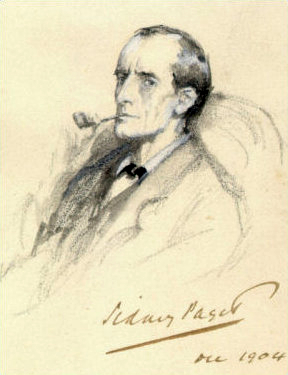Sherlock Holmes – I
November 15, 2010
Portrait of Sherlock Holmes (Source: Wikipedia)
Its hardly a surprise that I just love detective fiction. Doesn’t every bibliophile does? Whatever may be the case, the first name that comes to my mind whenever I think of detective fiction is not of an author, but of a character. A person who is so terse in his observation that he can tell you were recently divorced just on your first meet, without even asking you a question. Because he observes that your middle finger has a ring mark which you most probably removed quite recently. We may call it whatever we want, be it skill or keen observation, but none would doubt that he is a genius of the highest class. Well yes, you guessed it right. He indeed is Sherlock Holmes, the famous London based “consulting detective” created by the Scottish author and physician Sir Arthur Conan Doyle, himself a literary genius.
Holmes, who first appeared in publication in 1887, was featured in four novels and 56 short stories. The first story, A Study in Scarlet, appeared in Beeton’s Christmas Annual in 1887 and the second, The Sign of the Four, in Lippincott’s Monthly Magazine in 1890. The character grew tremendously in popularity with the beginning of the first series of short stories in Strand Magazine in 1891; further series of short stories and two novels published in serial form appeared between then and 1927. The stories cover a period from around 1880 up to 1907, with a final case in 1914.
Such was Holmes popularity that when Doyle tried to kill him in one of his stories, the public was outraged and Doyle had to bring back the character to life, conjuring up another plot for his story. This event is perhaps the single such instance in literary history where public demand had led the author to bring back a character back to life. The name of Holmes manages to conjure up pictures of horse driven carriages, beautiful lady villains, dark alleys of London and of course the sense of an ultimate chase to the finish of every crime.
Holmes is famous for his astute logical reasoning, his ability to take almost any disguise, and his forensic science skills to solve difficult cases. Infact he is so efficient in Chemistry that he is the only fictional character to be conferred honorary doctorate degrees in Chemistry and to be given a honorary membership into the Royal Society of Chemistry .
In the stories of Sherlock Holmes, apart from Holmes the most important character is that of Dr. John H. Watson, Holmes confederate and long time friend who also happens to be the narrator of most of his stories. It is Watson who sometimes brings to light the humane feelings in the otherwise expressionless, emotionless Holmes.
Holmes like all geniuses is at times quite eccentric. His philosophy of detection can be known from the following words of his:
“Detection is, or ought to be, an exact science and should be treated in the same cold and unemotional manner. You have attempted to tinge it “[A Study in Scarlet]” with romanticism, which produces much the same effect as if you worked a love-story … Some facts should be suppressed, or, at least, a just sense of proportion should be observed in treating them. The only point in the case which deserved mention was the curious analytical reasoning from effects to causes, by which I succeeded in unravelling it.”
—Sherlock Holmes on John Watson’s “pamphlet”, “A Study in Scarlet”.
“From a drop of water”, he writes, “a logician could infer the possibility of an Atlantic or a Niagara without having seen or heard of one or the other.”Holmes stories often begin with a bravura display of his talent for “deduction”. It is of some interest to logicians and those interested in logic to try to analyse just what Holmes is doing when he performs his deduction. Holmesian deduction appears to consist primarily of drawing inferences based on either straightforward practical principles—which are the result of careful inductive study, such as Holmes’s study of different kinds of cigar ashes or inference to the best explanation. One quote often heard from Holmes is “When you have eliminated the impossible, whatever remains, however improbable, must be the truth”.
The habits and personality of Sherlock Holmes would in itself fill a book. But still to give a brief overview, it is worth a mention that Holmes was unmarried although he was definitely in love once. He sometimes worked so hard that he forgot to take his food, or at times even sleep. He had a brilliant analytical mind and used it quite well in all his cases. An example can be got by the following incident.
Holmes’s straightforward practical principles are generally of the form, “If ‘p’, then ‘q’,” where ‘p’ is observed evidence and ‘q’ is what the evidence indicates. But there are also, as may be observed in the following example, intermediate principles. In “A Scandal in Bohemia” Holmes deduces that Watson had got very wet lately and that he had “a most clumsy and careless servant girl.” When Watson, in amazement, asks how Holmes knows this, Holmes answers:
“It is simplicity itself … My eyes tell me that on the inside of your left shoe, just where the firelight strikes it, the leather is scored by six almost parallel cuts. Obviously they have been caused by someone who has very carelessly scraped round the edges of the sole in order to remove crusted mud from it. Hence, you see, my double deduction that you had been out in vile weather, and that you had a particularly malignant boot-slitting specimen of the London slavey.”
Does anyone need to say anymore about Sherlock Holmes? I don’t think so!
Still we have got a few more things to say for this famous detective. Watch out for the next issue.
We welcome your comments at letters@friedeye.com

